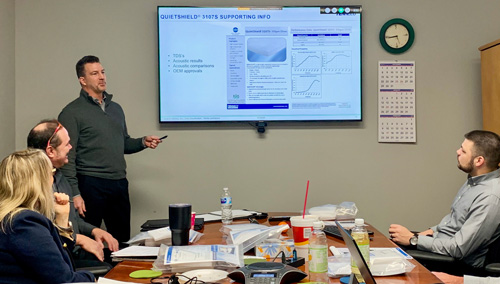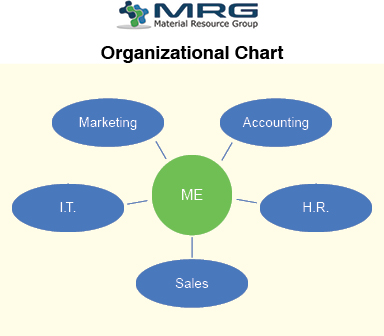
Three years after opening his agency doors, Erik Wandrie today heads the single‑man Material Resource Group, LLC, headquartered in Oxford, Michigan.
MANA-member Erik Wandrie explains that before he made the move to open the doors to his own agency in 2017, he was fairly well acquainted with what it took to be a rep. “However, when that time actually came, it was more than a little scary.”
According to Wandrie, Material Resource Group, LLC, “Being a rep and having my own agency was something that interested me for some time. My timeline, however, would have normally been four or five years from when I actually made the move.”
Early in his career he spent time in purchasing positions. “On a day-to-day basis in purchasing I was working with both reps and direct salespeople. That allowed me to learn about reps and be on the receiving end of what they did. I experienced the good and the bad among them and learned from them. I’d observe how they worked and tried to cherry pick what I thought were the good traits among them.”
Twenty years later after establishing himself in sales, Wandrie was presented with a fork in his career road when the company he was working for was purchased by another much larger company. “For the first year, they operated pretty much just as they always had and the compensation agreement I had with the original company was honored for a year. Then they presented the sales force with their future sales compensation plan. It was right then that I knew I didn’t want to continue as a direct employee of a large company. Fortunately, there was some good news in that the company was open to keeping me on as an independent rep after I explained my desire to start my own agency. As a result, I had one large principal right out of the gate, which made my transition fairly easy.”
Making the Move
Having made the decision to forge his career as a rep, Wandrie says it was scary. “The timing was hardly ideal. My son was in high school at the time and college was coming up quick. I certainly would have rather waited for him to be ‘off the payroll’ before I made the move. With a more condensed timeline than I would have liked, I realized I had to make the move. In addition to not having an established business plan, my biggest fear remained the cost of making the move and running my own business. As an independent rep I now had to cover all my own costs such as travel and insurance. What happens if I didn’t properly account for all those expenses? I went over all my numbers many times and also picked the brains of a number of other reps to make sure I wasn’t missing something.”
With that as a start, today Wandrie heads the one-man Material Resource Group, LLC, headquartered in Oxford, Michigan. The agency is focused on serving companies that convert or fabricate components for various industries such as automotive, medical, appliance, and general industrial. These companies use soft materials such as foams, lofted acoustic materials, scrims and adhesives to produce parts using manufacturing processes such as:
- Laminating.
- Rotary die cutting.
- Flat bed die-cutting.
- Water-jet cutting.
- Fusion molding.
- Thermoforming.
- Compression molding.
- Vacuum forming.
With that one principal under his belt, Wandrie was then faced with the task of adding manufacturers to fill out his line card. “The industry I serve is rather small and thankfully I knew many of the companies from past experience.”
He goes on to explain that the largest market his agency works in is the automotive industry. He explains a simplified supply chain where “the automotive Tier 1 companies provide completed assemblies such as full door systems, floor systems, instrument panels, etc., to their OEM customers. Tier 2 companies provide the large tier 1 companies with many of the components to make those assemblies and it’s the tier 3 companies that provide the raw materials used by the tier 2 companies. For most of my career, I worked directly for Tier 2 companies calling on Tier 1 customers. In 2016, however, I made the move down the supply chain to work for a tier 3 company and now call on tier 2 customers – some of which are former employers.”

Wandrie presents a new product line to a customer and communicates what he and the manufacturer will do to support the customer.
A Personal Sell
It’s in working with those Tier 2 customers that Wandrie describes the existence of a more personal sell. “With the large tier 1 customers there’s a tendency to make the sales process much more impersonal. There’s an electronic RFQ issued where quotes and price breakdowns are then entered into a supplier portal. The customer doesn’t necessarily want to meet personally with you. Moving to Tier 2 customers, there are more opportunities to employ a personal touch and more of a collaborative problem-solving mentality which I find very rewarding.”
In his efforts to identify and work with potential principals, Wandrie explains, “I’ve reached out to any number of companies which produce raw materials that can be used by my customers. Of the companies that are open to working with reps, many want you to sign on with a commission-only type arrangement. In the automotive industry that I sell in, there’s a great deal of work that has to be done over extended periods of time before revenue is finally realized. It can take 24 months or more to develop business.
“I understand the value I bring to the relationship and that’s why I let prospective principals know that, in the absence of a retainer relationship, it’s not a good fit for either of us. I actually had one company tell me that ‘our stuff will sell itself,’ which is why they were opposed to a retainer arrangement. Most of the companies I communicate with, however, understand the benefits of working with an independent rep and are open to negotiating a retainer to help bridge the gap before commissions start.”
Working With Partners
“The vision for my agency was and is to work with a small group of select principals (who I actually prefer to call partners). These companies understand the time and costs associated with hiring a direct salesperson, such as training, support, salary and travel. Working with an independent rep like me, they avoid most of those costs and also speed up the timeline for achieving new sales.”
In dealing with prospective principals, Wandrie explains that the subject of his being a one-man operation is often raised. “Sure, the topic of a single-man agency comes up. In fact, one of my current principals didn’t even care that I had formed an agency. They just wanted me and my specific experience. This made negotiating and wording the agreement between us difficult since they insisted that my name appears in certain sections along with my agency name. I suspect that it may be difficult to convince this principal to alter the agreement if/when my agency includes more customer-facing people. Other conversations regarding a one-man operation typically revolve around bandwidth and how much time I have for them.”
Large vs. Small
Staying on the subject of a small vs. a large agency, he continues, “I would think the reason a principal might prefer a small agency would be that they really know the person who will represent them and fully understand what they are getting upfront. With a larger agency, on the other hand, they may have the fear that there may be ‘weak links’ that don’t best represent their company or that a larger agency may have too many lines and not give them the time and attention they want.
“When I speak with potential principals, they know that I am a one-man agency with a very specific focus of customers and geography and that I will ultimately have a very limited number of principals. I explain that my customers use only a handful of category types of raw materials and that I want to fill those category slots with best-in-class products and companies. I represent only three companies today and see five or six as the magic number for the future. If/when I grow my agency beyond just me, it would likely be to divide up the geography and not necessarily to add more principals. I continue to evaluate this as I add and digest new principals.”
On a personal level, he adds that there are some positive and negative considerations when he views the size of his agency. “Being a one-man agency makes disconnecting or vacationing more difficult since there is no one to really pick up the ball if I need or want to be out. On the plus side, my principals are all very good about having me leave an out-of-office message which directs customers and prospect to some key people within their companies.”

While there is a bit of humor behind this organizational chart, Erik Wandrie admits it fairly represents the distribution of responsibilities in his one-man agency.
Finally, Wandrie makes the point of how valuable his membership in MANA has been for his fairly new agency. “When I made the move to open my own agency, I reached out to some established reps that I knew and they all suggested that I join the association. Over the time I’ve been a member, I’ve made use of the MANA contracts, its legal counseling (I work closely with one of MANA’s attorneys), and I read Agency Sales regularly from cover to cover.”
MANA welcomes your comments on this article. Write to us at [email protected].

